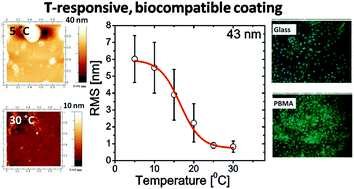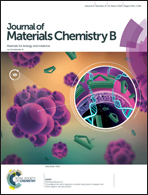Glass transition in temperature-responsive poly(butyl methacrylate) grafted polymer brushes. Impact of thickness and temperature on wetting, morphology, and cell growth
Abstract
Poly(n-butyl methacrylate) (PBMA) grafted polymer brushes attached to glass were fabricated in a three-step process involving surface initiated atom transfer radical polymerization. The surface properties of the coatings after subsequent fabrication steps were confirmed using ToF-SIMS and ellipsometry. Measurements of water contact angle and AFM revealed temperature-induced changes in the hydrophobicity and morphology of the coating. The glass transition temperatures (Tg) of the PBMA coatings with different thicknesses were determined from the AFM measurements. For the PBMA grafted brush coatings with thicknesses less than 62 nm, Tg increases sharply with increasing thickness. The PBMA grafted coatings of thickness equal to 86 nm and 43 nm as well as control glass substrates were used as substrates for culturing a urinary bladder cancer HTB-5 cell line. After 144 h of culturing, a well-developed monocellular layer may be observed on the PBMA coating of thickness equal to 86 nm. In turn, the cells incubated on thinner (43 nm) PBMA coatings as well as on a control glass sample only start to form a confluent layer.



 Please wait while we load your content...
Please wait while we load your content...